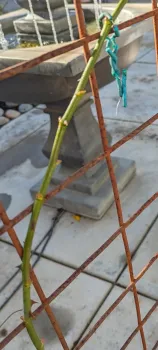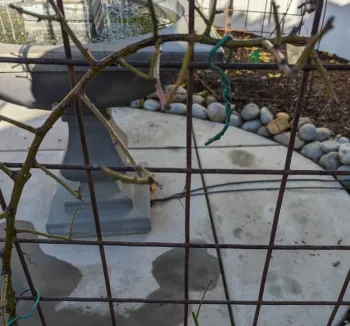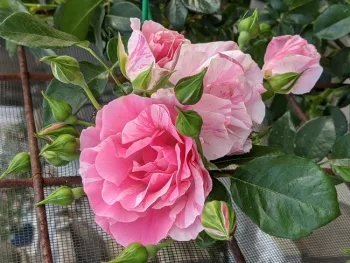It is finally time to start pruning your roses! In last month's column, I talked about pruning safety: wearing gloves, sleeves that cover your arms to protect them from thorns, wearing eye protection, etc. I also wrote about preparing your bypass pruners by sharpening them and keeping them clean. For some roses, I use either a pruning knife or loppers to remove canes. I use the loppers or a pruning knife if the canes are too thick for my pruners. Also, if you want to move a rose from one spot in the garden to another, now is the best time — when they are pruned and dormant.
You are going to prune your canes to an outward facing bud. What is an outward facing bud? Buds are formed in the “axial” where the leaf meets the cane. If you look closely, you will see a little bump underneath the leaf. About one-quarter inch above that is where you are going to cut. Prune to an outside facing bud (not one facing the inside of the bush). That bud will produce a flowering cane.

Cut out old and scarred canes. Cut out spindly canes. Cut out one or both canes that are crossing each other. Those canes can rub against each other, and diseases can then infect both canes. The center of the plant should not be crowded with canes, but open and airy. Again, dispose of the leaves and debris in the green bin.
When pruning, make sure the cane's pith is white and not dark. The pith is the center part of the cane. It should look like the inside of an apple. If it is dark, keep cutting the cane back until the pith is white. You may have to cut the cane all the way back to the soil or graft. That is OK. Those dark centers indicate that the cane is in decline or diseased. Removing it should spur new growth for your rose.
Climbers and rambling roses are pruned differently. What is a climbing rose and what is a rambling rose? A rambling rose blooms once in the spring. A climbing rose will continue to bloom throughout the spring and summer into the fall. Start to prune climbing and rambling roses only after you have had them for a couple of years. This allows them time to form nice arching canes. These are called the main canes. Keep about 4 to 6 of those nice arching main canes and prune any old, crossing, diseased canes from the bush. Those arching canes will have lateral canes that come out from them. Cut those lateral canes to about 3 to 5 axials (where the leaves come out). Those lateral canes are the ones that will be producing flowers in the spring.


Climber and rambling rose canes should be tied to a structure such as an arbor as close to a 45-degree angle as you can get, without breaking the cane. That angle will stimulate lateral growth and blooms. Tie them loosely. You don't want the tie to girdle the cane.
Now is the time to clean up around your rose bush. Make sure you have removed all of the leaves off of the stems and dispose of them properly. Removing the leaves helps prevent over-wintering spores of a fungal disease to re-infect the rose.
Rambling roses are climbing roses that bloom only once in the spring/early summer (but oh, what a display!). Prune them lightly after they have finished blooming. If you prune them later, you will be pruning off next year's flowers.
When your roses start to put out new growth and that growth is about 2 inches long, it is time to fertilize. I use a good organic rose fertilizer, or alfalfa meal (not alfalfa pellets), and compost. Sometimes our alkaline soil doesn't allow the rose bush to utilize the iron in the soil. This causes the rose leaves to look whitish instead of green. That means that your rose needs extra iron. There are lots of good iron plant supplements (not the kind you take!) in the marketplace. You may need to feed that iron supplement to the rose, if the leaves overall are a light, whitish green. Check your soil with a good soil test to see if this is necessary. Don't add fertilizer and supplements just to add them. More is NOT better for the rose, and it can be bad for the environment as well. Just use what your rose needs.
I also mulch around my roses. Put a good 3-inch layer of mulch around the drip line of the rose and not next to the canes. That will help to save water and keep your roses cooler in the summer. You will also have to weed less! A bonus! That mulch will eventually break down and enrich your soil. Another bonus!
Assess the irrigation system to make sure it is in good working order. If you follow the steps above, in about 8 to 10 weeks you will be rewarded with beautiful blooms.
Rose of the Month — Flamingo Dancer

Earlier in the article, I showed you a climbing rose that had been pruned. Here is what it looks like in the spring. This rose, called Flamingo Dancer, is one gorgeous rose that tolerates our soil and weather conditions beautifully. It also makes a lot of hips in the fall (great for tea if you don't use insecticides). Because it's a semi-double flower rose, the bees find it irresistible. It's great for our pollinators! Flamingo Dancer was bred by Burling Leong, who has her own nursery in Visalia, Calif. Burling has bred several amazing roses. Her nursery is a beautiful place to visit. She worked for many, many years for the famous rose breeder Ralph Moore (whose nursery was also in Visalia).
Until next time . . . Life is not always going to be roses and rainbows. You are going to have uncomfortable moments. It's what we do with those moments that is going to count and determine our destiny. - Lana


